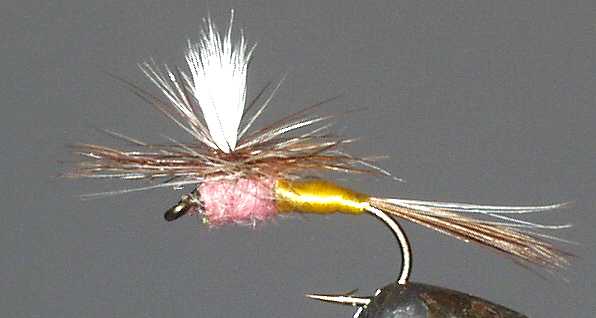The Tup's Indispensable Parachute Dry Fly
The Tup's Indispensable is a popular fly designed by the professional tyer Mr R.S.Austin, a tobacconist who worked in Tiverton, Devon, South West England in 1900. This version of the old Tup pattern is popular when pale midge or caenis are on the menu.

PARACHUTE EMERGER DRY FLIES. Hook size 12 14 16 18 20 24 - $US each
The Tups Indispensable Parachute is fished dry on the water and moved slowly amongst fish that are feeding near the surface. It can be used effectively in these conditions or for high summer when reduced water flow and high temperatures can make the trout very fussy. It is a useful pattern used to represent light colored mayfly like the pale watery or small spurwing female spinners. Mr Austin sent a sample of dubbing with tying instructions on how to tie an unnamed fly pattern which he had found particularly successful in imitating female olive spinners to Mr G.E.M. Skues, father of modern nymph fishing. Skues followed the instructions and made the fly. He spent most of the following September testing the fly on his local water the River Ichen and was so impressed that he published his findings.
He also found it was a very effective imitation of a Pale Watery natural insect. He is accredited with naming the fly and suggesting the addition of the crimson seal fur giving the thorax a pinkish hue. The recipe for the pattern was kept secret and thus Mr Austin obtained a monopoly on selling the fly. The article was widly read and lots of orders were placed. “The fly became so popular that Mr Austin became utterly sick of tying it,” Skues wrote in a letter. He was one of two people given the dressing secret by Mr Austin. It was kept a secret until after his daughter, who continued the business, had retired.
The term parachute fly is given to flies in which the hackle is tied round a projection affixed to the top of the hook shank near the eye so that the hackle lies horizontally across the hook which it covers in the manner of an open umbrella. The weight of the hook underneath the circular hackle balances the fly which falls lightly on the water parachute fashion. Various patterns are tied in the parachute style and a Scottish tackle firm was the first to commercially market these flies a long time ago. It is not certain who invented them but an American called William Brush of Detroit applied for an American patent for the idea in 1931 and it was granted in 1934. The patent related to the projection on the hook and not the fly itself.
The traditional way of dressing dry flies with upright wings and hackles that make the fly stand high on the water's surface may be very pleasing but it is not necessarily the best design for catching fish in some anglers opinions. The parachute dry fly style of dressing allows the fly to sit well down in or on the surface film, mimicking either an emerging mayfly dun filling its wings, a spent spinner, stillborn, floating nymph or a crippled drowning fly trapped in the surface film. They can be dramatically more effective at getting takes. Some traditionalist will not use them but I find them very effective and easy to cast correctly. I have found them more suited to still water fishing as once a ripple or two has broken over them they become waterlogged. The softer landing, the delicate presentation is one of this patterns principle benefits. The parachute effect of the hackle slows down the descent. It does not spook the fish as much as a normal dry fly. They are one of my favorite lake flies. When the trout are rising and taking food with a gentle sipping action these are the flies to use.
When the mayflies have stopped emerging and the surface action has died down. The fishing is not over if you know where to look. Go for a walk down the riverbank and look for bankside eddies, areas of slow slack pockets of water near faster moving water. A lot of mayflies do not successfully emerge during the hatch. They are referred to as cripples or stillborn. Others are flipped over, capsized in choppy water. They seem to collect in these eddies. You will find trout rising to them long after the original hatch has finished. Cast a Parachute into these pockets and let it drift. It is a great way to extend your surface fishing time.
Fly Fishing books

